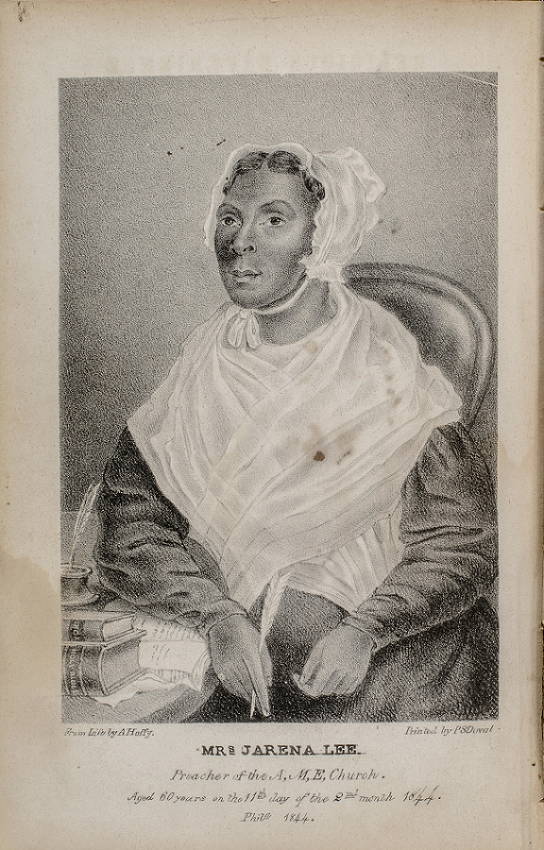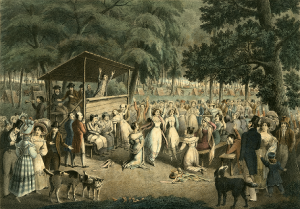Jarena Lee was born on February 11, 1783, in Cape May, New Jersey. Her parents were a free Black couple. Jarena’s family was very poor. When she was seven years old, her parents sent her to work as a domestic servant for a white family that lived 60 miles away. Jarena probably worked long hours doing very hard jobs for her employers. But she still found time to teach herself to read and write.
When she was about 20 years old, Jarena moved to Philadelphia. She continued to work as a domestic servant, and in her free time she visited the many churches in the city. Jarena was a very spiritual person, but she had never found a religious community that was right for her. That all changed when Jarena attended a service at Mother Bethel African Methodist Episcopal (A.M.E.) Church and heard Bishop Richard Allen speak. Allen was a formerly enslaved person who founded the Church when the parish he used to attend began segregating its services. Mother Bethel’s parishioners were all Black. The services reflected Jarena’s feelings and experiences. She was so inspired that she chose to be baptized into the church.
Around 1807, Jarena felt like God was calling her to become a preacher. Women were not allowed to speak in most Christian churches in early America. This policy was based on a line from the Bible that said “Let your women keep silence in the churches: for it is not permitted unto them to speak.” When Jarena asked Richard Allen if she could preach at Mother Bethel, he told her it wasn’t allowed. Jarena was very disappointed. She later wrote: “If the man may preach, because the Savior died for him, why not the woman? seeing he died for her also. Is he not a whole Savior, instead of a half one?”
In 1811, Jarena married Pastor Jason Lee and moved with him to New Jersey. Jarena gave birth to six children but only two survived. Throughout her marriage, Jarena felt God was calling her to preach, but her husband told her this was not allowed. Being silenced in this way caused Jarena mental and physical discomfort.
Being silenced caused Jarena mental and physical discomfort.
Jarena moved back to Philadelphia when her husband died in 1817. She started attending services at Mother Bethel again, and her conviction that God wanted her to preach grew even stronger. In 1819, she attended a service led by a guest preacher. In the middle of the sermon, he stumbled over his words and became so nervous he couldn’t speak. Jarena stood up and began to preach, finishing his sermon. Richard Allen was so moved by her sermon that he decided God had chosen Jarena to be a preacher. He authorized her as the first female minister of the A.M.E. Church.
Jarena decided to become a missionary. She traveled on foot all over the country. She would preach to any group of listeners, but she sought out African Americans in particular. In her experience, most people were kind. They gave her rides, places to sleep, meals, and money. She needed all the help she could get. Male preachers received a small salary, but women were not paid. Jarena preached wherever she could: in homes, schools, and open fields. She often competed for converts with preachers from other Christian churches. Remembering a particularly large meeting, she wrote: “We had the victory, as there were twenty-one persons joined.” The Baptists working the same event won only five.
Jarena was part of a broad spiritual movement that historians now call the Second Great Awakening. The Second Great Awakening was a period of intense religious enthusiasm that lasted from the 1790s to the 1840s. It reached its peak in the 1820s, just as Jarena began her missionary work. The Second Great Awakening was not just a religious movement. It was also a social revolution. One of the central ideas was that anyone could commit to religion and be a spiritual leader. This was an especially powerful message for women, who were also being told that they were the moral foundation of the new nation. Women flocked to the huge religious meetings, which characterized the Second Great Awakening, and converted in huge numbers. About 100 women also became preachers like Jarena and traveled the country seeking converts. But these women did not only spend their energy on religious endeavors. Many used their platform to popularize reform movements like temperance, abolition, and women’s rights. Jarena joined the American Anti-slavery Society in 1839. She and her compatriots were determined to enact a spiritual and social revolution that would transform the new nation, just like the American Revolution had established it.
Jarena Lee and the other female preachers of the Second Great Awakening were trailblazers. At the start of her life, Jarena was not allowed to speak out at church services because people believed it went against the teachings of the bible. By the time of her death in 1855, religious women like Sojourner Truth were meeting with U.S. presidents to demand the abolition of slavery.
Vocabulary
- abolition: The movement to end the practice of slavery in the United States.
- A.M.E. Church: African Methodist Episcopal Church. A Christian church formed by the Black community.
- minister: A person who can lead Christian church services.
- missionary: A person who travels to remote places to teach other people about their religion and convert them.
- parishioner: Member of a church community.
- preach: To deliver a speech on religious subjects.
- segregate: Separate by race.
- sermon: Speech given by a minister during religious services.
- temperance: The movement to eliminate the consumption of alcohol.
Discussion Questions
- Why did Richard Allen and Jason Lee bar Jarena Lee from preaching? What eventually changed Richard Allen’s mind?
- Why were women particularly drawn to the religious fervor of the Second Great Awakening?
- What does Jarena Lee’s life teach us about the evolution of womanhood during the Federal period?
Suggested Activities
- APUSH Connection: 4.10 The Second Great Awakening
- Teach this life story together with the following to create a larger lesson about women and social reform in the early United States: Benevolent Societies, Life Story: Sojourner Truth, Salem Female Anti-slavery Society, Pro- and Anti-Slavery Literature for Children, and Life Story: The Grimké Sisters.
- Historically, religious reform movements in the United States have allowed marginalized people to assert their personhood and reshape their narrative. To learn about an example from the First Great Awakening, see Life Story: The Public Universal Friend.
- To learn about other women who worked publicly to shape U.S. discourse and policy, see: Federalist v. Anti-Federalist, On the Capabilities of Women, Benevolent Societies, Life Story: Dolley Madison, and Life Story: Margaret Bayard Smith.
Themes
AMERICAN CULTURE








